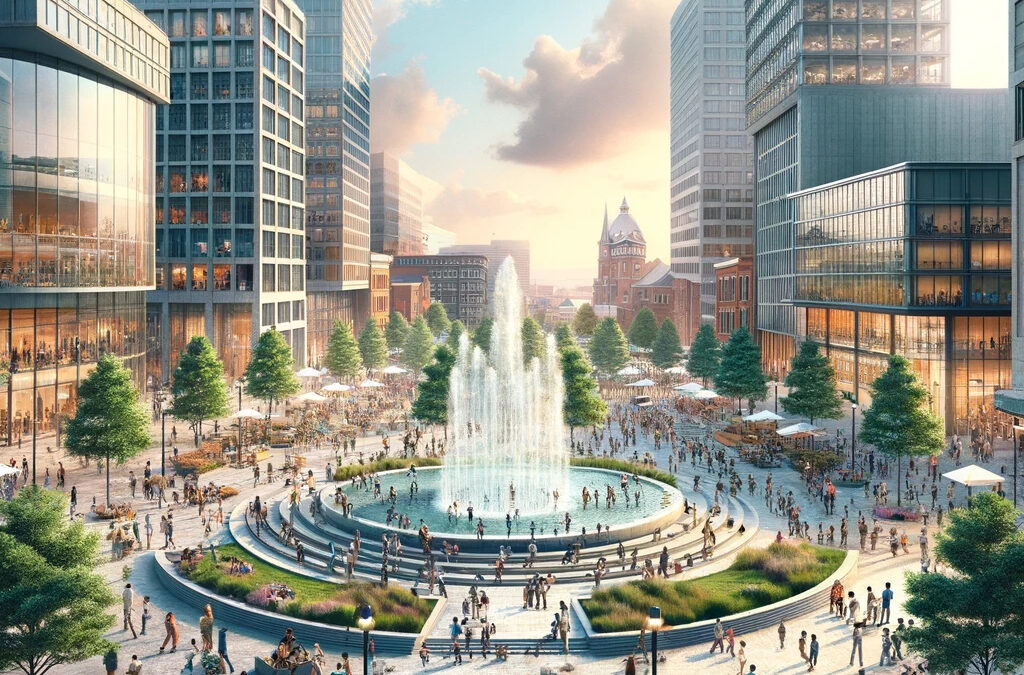In modern urban landscapes, commercial real estate (CRE) projects are more than just buildings; they’re part of the larger community fabric. The inclusion of community spaces within these projects is becoming increasingly essential, not just for enhancing property value but for fostering social connections, promoting inclusivity, and supporting local economies. This is true in Maryland, Washington DC, Virginia and around the world. Today, we’ll explore the importance of creating community spaces in commercial real estate projects, offering insights for developers, investors, and urban planners on how to integrate these vital areas into their projects. And we’ll use examples from the DC and MD commercial real estate leasing market as examples.
The Value of Community Spaces
Community spaces in commercial real estate projects can take many forms, from public plazas and green parks to communal meeting rooms and event venues. These spaces offer numerous benefits:
Enhancing Property Appeal: Well-designed community spaces attract visitors and tenants, increasing foot traffic and occupancy rates.
Promoting Sustainability: Green spaces contribute to environmental sustainability, improving air quality and providing essential green cover.
Fostering Social Connections: Spaces that encourage social interaction help build a sense of community among tenants and visitors, leading to higher satisfaction and retention rates.
Supporting Local Economies: Community spaces often host local events, markets, and gatherings that support small businesses and local artisans.
Strategies for Creating Effective Community Spaces
Creating effective community spaces requires thoughtful planning and design. Here are some strategies to consider:
Understand the Community’s Needs: Engage with the local community to understand their needs and desires. This could involve surveys, workshops, or public meetings to gather input.
Flexible Design: Design spaces that are adaptable and can host a variety of activities, from farmers’ markets to outdoor concerts and corporate events.
Incorporate Nature: Nature plays a crucial role in well-being. Incorporating green spaces, gardens, and water features can enhance the aesthetic appeal and provide a tranquil environment for relaxation and recreation.
Ensure Accessibility: Community spaces should be easily accessible to everyone, including those with disabilities. This includes physical accessibility as well as affordable and inclusive programming.
Partner with Local Organizations: Collaborate with local businesses, non-profits, and cultural organizations to activate these spaces with programming that reflects the community’s character and needs.
Case Studies: Successful Community Spaces in Baltimore and DC
The cities of Baltimore and Washington, DC, offer inspiring examples of how commercial real estate projects can successfully integrate community spaces:
Harbor East in Baltimore, MD: This mixed-use development has transformed a portion of Baltimore’s waterfront into a vibrant community hub. With its blend of high-end retail, dining, residential, and office spaces, Harbor East includes beautifully landscaped plazas and waterfront promenades that encourage public gatherings and community events, enhancing the area’s appeal and connectivity.
The Yards in Washington, DC: Situated along the Anacostia River, The Yards is a prime example of successful community space integration within a larger commercial and residential development. The Yards Park features open lawns for events and activities, a boardwalk, and interactive water features. It’s a popular gathering place for community events, concerts, and festivals, fostering a strong sense of community and belonging among residents and visitors alike.
Center Plaza in Baltimore, MD: This revitalized urban space in the heart of downtown Baltimore serves as a communal backyard for the city’s residents and workers. With its open green space, seasonal ice skating rink, and programmed events like outdoor movies and concerts, Center Plaza is an excellent example of how commercial real estate projects can include community spaces that serve diverse uses and bring people together.
Conclusion
Incorporating community spaces into commercial real estate projects offers a win-win scenario for developers, tenants, and the wider community. These spaces not only enhance the appeal and value of real estate projects but also contribute to the health, well-being, and vibrancy of urban environments. As the DC and MD commercial real estate leasing market continues to grow and evolve, the role of community spaces will only become more critical. And we’re excited to be a part of building those spaces.
If you are interested in a free broker opinion of value or just learning more about investing in commercial real estate in Maryland, Virginia, or Washington DC, please contact us. Avenue Real Estate is a leading full service commercial brokerage in the Baltimore and Washington DC areas and we would love to help you explore your options and make informed decisions about commercial real estate investments.

